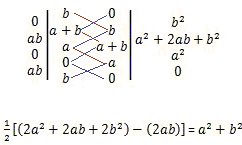Pythagorean Theorem from the Shoelace Formula
John Molokach also observed that the Pythagorean theorem follows from Gauss' Shoelace Formula. The formula gives the area of a polygon
Area(A1A2...An) = ½|∑(xjyj+1 - xj+1yj)| = ½|∑xj(yj+1 - yj-1)|,
where the sum is taken for j = 1, ..., n and the indices are defined cyclically:
For the square with vertices A1(b, 0),

|

|
On the other hand, if c is the hypotenuse of the right triangle with vertices
A question could be asked whether the Shoelace formula, in itself, is based on the Pythagorean theorem, causing a vicious circle in proving the latter. Eschewing this question for the time being, we present Roger Nelsen's synthetic proof without words that algebraically is equivalent to the above derivation:

In the first figure on the right, one of the darker triangles has area a²/2, the other one - b²/2. The light triangles have areas
a²/2 + b²/2 + (a + b)²/2 - 2ab/2 = a² + b².
|Pythagorean Theorem| |Contact| |Front page| |Contents| |Geometry|
Copyright © 1996-2018 Alexander Bogomolny73574021
